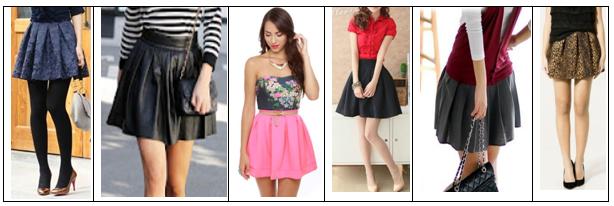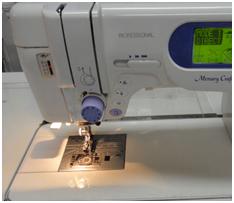A Skirt A Day
If you have mastered sewing straight seams, being sure to keep a 1.5cm seam allowance, try making a different skirt a day.
Start with a simple gathered skirt, then work your way up to a pleated skirt with a waistband, zipper and button closure.
Monday Make a gathered skirt with an elastic waist in a casing
Tuesday Make a gathered skirt with overlay and an elastic waist
Wednesday Make a gathered skirt with a waistband and zipper
Thursday Make a gathered skirt with wide elastic as a waistband
Friday Make a pleated skirt with a waistband, zipper and button closure
A Skirt A Day Details
Monday 9am – 12pm
Make a gathered skirt with an elastic waist in a casing!

So you know how much fabric you will need, you’ll first have to take some measurements:
- Waist measurement
- Hip measurement (at widest point – about 10cm below your waist)
- Skirt length from your waist down to where you want the skirt to finish
Materials:
1. 1 cm wide non-roll elastic (this has vertical ridges on it)
= waist measurement
2. skirt fabric
= length of skirt + 6cm if 1½ x hip measurement is less than width of fabric (90cm or 115cm)
OR
= 2 x length of skirt + 12cm if 1½ x hip measurement is greater than width of fabric (90cm or 115cm)
3. matching thread
Tuesday 9am – 12pm
Make a gathered skirt with overlay and an elastic waist!

So you know how much fabric you will need, you’ll first have to take some measurements:
- Waist measurement
- Hip measurement (at widest point – about 10cm below your waist)
- Skirt length from your waist down to where you want the skirt to finish
Materials:
1. 1 cm wide non-roll elastic (this has vertical ridges on it)
= waist measurement
2. skirt fabric
= length of skirt + 6cm if 1½ x hip measurement is less than width of fabric (90cm or 115cm)
OR
= 2 x length of skirt + 12cm if 1½ x hip measurement is greater than width of fabric (90cm or 115cm)
3. overskirt fabric
= length of skirt if 2 x hip measurement is less than width of fabric (90cm or 115cm)
OR
= 2 x length of skirt if 2 x hip measurement is greater than width of fabric (90cm or 115cm)
4. matching thread
Wednesday 9am -12pm
Make a gathered skirt with a waistband and zipper!

Practice inserting a lapped zipper in fabric samples before sewing this skirt.
Lapped zippers are the easiest zippers to sew.
So you know how much fabric you will need, you’ll first have to take some measurements:
- Hip measurement (at widest point – about 10cm below your waist)
- Skirt length from your waist down to where you want the skirt to finish
Materials:
1. skirt fabric
= length of skirt + 16cm if 1½ x hip measurement is less than width of fabric (90cm or 115cm)
OR
= 2 x length of skirt + 22cm if 1½ x hip measurement is greater than width of fabric (90cm or 115cm)
2. matching zipper 20cm – 25cm long
3. matching thread
3. matching thread
Thursday 9am -12
Make a gathered skirt with wide elastic as a waistband!

This skirt is a little bit trickier than the earlier skirts, as you will be stretching the elastic as you sew on the skirt, so keeping the 1.5cm seam allowance as you sew your seams is more difficult.
So you know how much fabric you will need, you’ll first have to take some measurements:- Waist measurement
- Hip measurement (at widest point – about 10cm below your waist)
- Skirt length from your waist down to where you want the skirt to finish
Materials:1. 3cm-5cm cm wide flat elastic
= waist measurement
2. skirt fabric
= length of skirt + 4cm if 1½ x hip measurement is less than width of fabric (90cm or 115cm)
OR
= 2 x length of skirt + 8cm if 1½ x hip measurement is greater than width of fabric (90cm or 115cm)
3. matching thread
Friday 9am – 12 Make a pleated skirt with a waistband, zipper and button closure !

As well as having a lapped zipper, you will need to be able to sew a button hole.
Choose a button that fits into your automatic buttonhole foot, to make things easier.
The inside of the waistband will be finished by stitching in the ditch.
So you know how much fabric you will need, you’ll first have to take some measurements:
- Hip measurement (at widest point – about 10cm below your waist)
- Skirt length from your waist down to where you want the skirt to finish
Materials:
1. skirt fabric
= length of skirt + 15cm if 2 x hip measurement is less than width of fabric (90cm or 115cm)
OR
= 2 x length of skirt + 30cm if 2 x hip measurement is greater than width of fabric (90cm or 115cm)
2. 15cm – 20cm long zipper
3. matching button 1.5 – 2.5cm diameter
4. matching thread
Email getsetsew@gmail.com to book any or all of these sewing classes, which are held in Perth, Western Australia.











